Intercity Insights - what we learned about playing Jet Lag: The Game
We played Jet Lag: The Game - Hide and Seek in Germany last July. We spent the return journey analysing, and here, finally, is the writeup of our thoughts on how to improve the game...
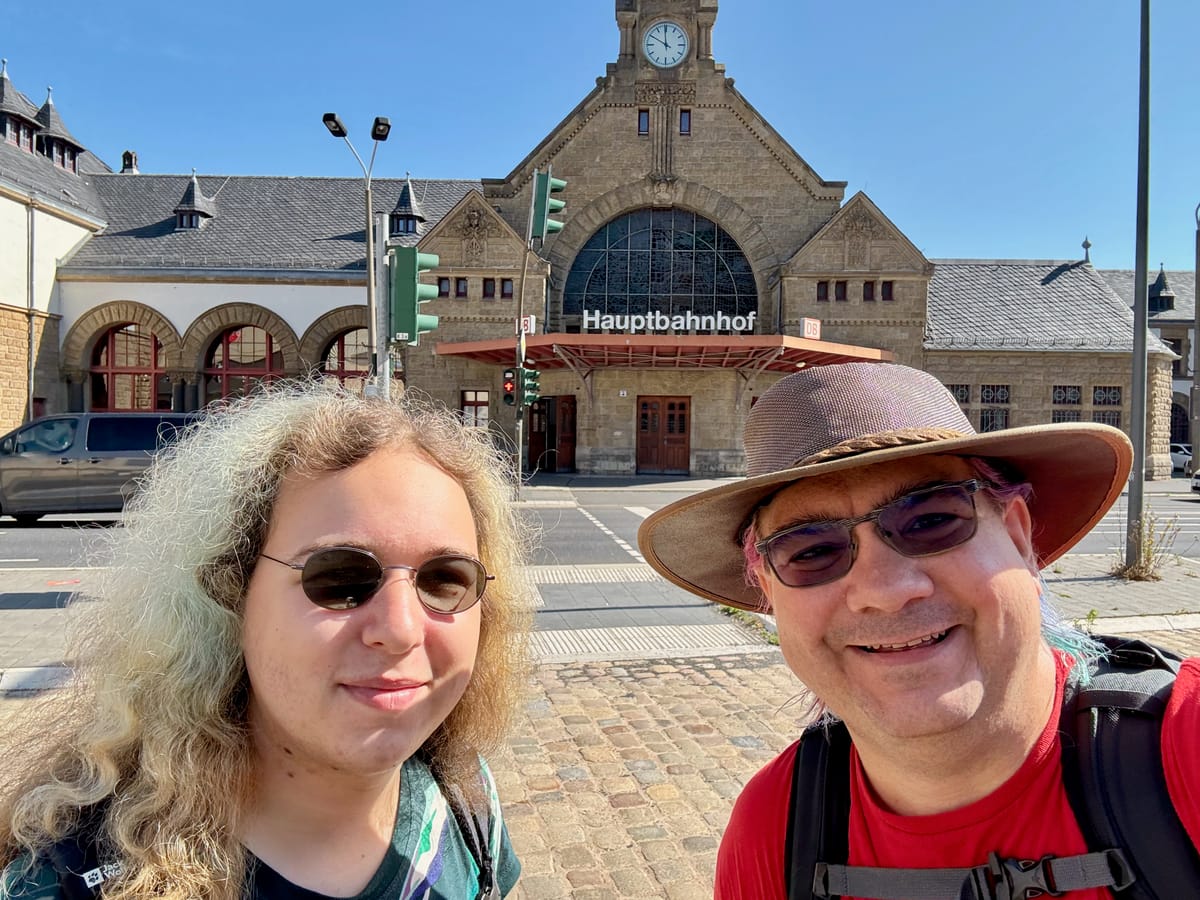
Last July I played Jet Lag: The Game - Hide and Seek in Germany with a couple of friends - Ash and Julia. After the game, we took a nice long train back towards Köln via the beautiful Rhine Valley railway, and spent the trip basically dissecting what we learned about the game from playing it. In the spirit of the Layover podcast, we present to you our Intercity Insights...
On the Hider
The game is centred around the hider: they choose the hiding locations, they use curses to modify the game, and ultimately, they are reacting to what the seekers are doing and are shaping the game. In a very real way, the role is not unlike that of a Dungeon Master in a game of Dungeons and Dragons.
And, like any other Dungeon Master, you have the power to make or break the game. You should not forget that this is a game, and that ultimately everyone should be having fun, including yourself. Sure, you should try to extend the hiding time as much as possible, but also give the Seekers a sporting chance. Don’t stretch out the answering of the picture questions for a full 20 minutes, if you can avoid it, that effectively limits the game to three pictures an hour, and will annoy the hell out of your Seekers at the end of the game day. The aim of the game is for them to find you… eventually. Accept that it will happen, and make it only moderately difficult for that to happen.
Wheaton’s Law applies: Don’t be a Dick.
Things we learned the hard way: do not chain your curses using timed send mode on your chat app. If you’ve just spent an hour unable to ask questions for some reason, it’s really unfair to keep them unable to advance in the game like that. Let them get one question in and then curse them.
In general, being fair handed and generous will get you a similar response from your seekers. Your job is to make the game fun first, and make them take as long as possible second.
On the Seekers
The official rules state that the seekers are a Team. Lean on each other’s strengths, and split tasks: for example: have one person look through the map trying to find clues and discard stations whilst the other finds possible itineraries for the remaining areas, preferably the one that knows how to wrangle the railways or the apps better.
Whilst it seems to be an unspoken rule in the Nebula/Youtube series, it’s never explicitly stated that the team has to stick together. If you have to do a detour up a mountain, it’s perfectly within the rules for one person to stay with the bags whilst the fitter one goes on a hike. Similarly, two people can split up and search a park twice as quickly as one.
On the Map
You do not have a graphics department, and you should not need an advanced orienteering course, pencils, paper, a gazette, a pair of compasses, a ruler, a sextant, a chronometer, and a set of paper charts in order to play this game. This is a game of hide and seek, not a map drawing exercise.
So, you should absolutely depend on this wonderful open source map generator in order to handle the mapping for your game. It has almost all of the mapping questions in it, with a few limitations. You will need to work out what the OSM zone equivalents of the Administrative level questions are ahead of time (in the case of Germany, it was layers 4, 6 and 8, for example), and also some of the larger questions complex for it to calculate, in a way that will fail silently.
Practical considerations:
- The app cannot calculate “are you closer to the coastline than us?” for the entirety of Germany. Due to the geography of Germany we were using that question as a proxy for “are you further north than us?” We agreed beforehand to substitute that question with a 1km North-South thermometer. You may need to find similar compromises with your questions.
- Each question narrows down the subsequent area for calculations. So in order to maintain performance, as soon as you have worked the furthest your Hider could have gone, draw a suitable radius (based on the starting station) with a safety margin. For example, if you have worked out that the train timetable allows for your Hider to have gone at most 127 km away, draw a 140km radius on the map. It will make things quicker as you ask questions.
- Similarly, as soon as you enter the End Game, draw a radius around the station. Hiding zone mode has an annoying habit of turning off when you least expect it, and it leaves you waiting a few minutes whilst it recalculates all possible stations. This will ensure you don’t have massive problems with really complex questions being drawn over 20km instead of 2km
- You can use hiding zone mode to keep track of which stations you think your hider might or might not be. If you copy and paste the full map, it will keep include the active and inactive hiding areas, so you can share them with your fellow seekers, but also be aware this information will travel to the hider if they get the same url
- The map is a lot easier to manage on a laptop than a tablet or a phone, but you can and should use the phone for the end game
- Check the units of your questions and of the hiding zones occasionally. We found that the map switched from metric to imperial without noticing, and one of our hiders ended up outside the hiding zone because they had set their area to 0.8miles instead of 0.8km (which was the hiding zone we had chosen for our game)
- Don't be afraid of sharing the map with the Hider... they are playing the same map as you, and it's more of a sanity check that you both have the same data. If you don't want to know what hiding zones are still in play, then a screenshot will do. "Is this map what you're seeing?" was a free question for us.
On the Questions
We spent the first two rounds complaining that the questions were badly balanced. Especially because there were only two radars and one thermometer question that are suitable for the end game. Then on the third game we realised that we were thinking the wrong way: the questions were constraints on the game, and we should work with them to try and discover the information we needed, rather than try to get them to fit our idea of creating a radius and then quartering that radius in order to find out where to head next.
Why ask a 100km radius, when if you’re in the middle of a Bundesland (Province) you can ask if the hider is in the same one as you and get a result that’s functionally equivalent? You can be creative about being closer to a city than you to work out whether to keep going towards a city or not. There’s an amazing amount of information to be gleaned from the creative use of some of the smaller questions - if you’re in the right location. Asking whether they’re closer to a consulate than you when you’re in the middle of a rural area of Germany for example, creates some really weird bubbles on the map, but gives valuable information.
Similarly, don’t be afraid of asking questions. We all at one point or another decided we didn’t want to ask a question a second time, or didn’t feel like we wanted to give the hider the satisfaction of two cards in a tentacles question. This was a mistake. The fear of being cursed was too high.
And, simulate, simulate, simulate. Since you are using the mapping app, try different questions out on downtimes in the train or whatever. Try to think a step or two ahead, as maybe travelling to a particular station allows you to both get in a long distance thermometer and a measuring or matching question at the station on the other end. This, more than anything, significantly improved the gameplay of the long distance game.
With that in mind, one bit of advice we can give is: simulate the game a few times before actually playing it for real. This allows you to at the very least get a feel for the mapping app, and also how powerful the questions can be, as well as also a feel for the railway timetabling apps. It won’t necessarily help with the endgame so much, but even then try it at least once. We simulated a game online once before we went to play it for real, and thoroughly regret not giving it a few more times. The third game was much more fun as a result of what we’d learned the first two games.
There was an ambiguity in the rules that we took a decision on: Starting a Thermometer does not count as asking a question. There are rules on the amount of time a question needs to be answered in, and that applies to when the thermometer is finished. As such, other questions can be asked in the meantime, and curses can be used. We did feel that if a curse blocks asking questions, it does not apply to a thermometer that has already been started, though.
In the large game, the picture of the tallest building visible from the station is a hugely advantageous picture, as it lets you reliably know when you are in the Endgame, and if the location is pretty distinctive, it's also visible from a satellite view.
On the Hider Deck
The deck is huge. Both in number of cards (over 100) and in size (it’s a full poker deck size). We definitely had issues with both shuffling and just manipulating the deck.
I’m going to come right out and say it: we used our own copy of the deck, because Nebula were hit with several setbacks with delivery, and in the end we printed out our own copies of the cards, and used an online copy of the rules. We’ve received our own copies of the game now, and what we said above is true for the official cards. Our cards were a little thicker than the official ones, though, so it made the manipulation even more awkward.
Think before you travel how you’re going to keep the deck together, and still keep the deck, the active cards, and the discard pile separate when moving. A few rubber bands or hairbands help, but if you have a bag with some extra compartments that can also help.
On Curses
The biggest issue we had with curses is that many of them don't have time limits, and the rules don't have a veto option. This became a problem when, for example, the seekers were asked to do a five minute video of a bird, and none was to be found. 90 minutes later we just ended up saying "this can't be done" and lifted the curse.
Our suggestion for future games: Set a time forfeit for curses that block questions or travel, this can be individually for each curse, or with a default rule. We feel that for a Large game, curses should last no longer than an hour. If the hour has passed, then the Seekers can state that the curse is lifted. We also feel that a curse can be vetoed by the Seekers if an extra 50% time penalty is applied, so curse with a default time limit of an hour can be vetoed for a 90 minute time bonus for the hider at the end of the round. The idea is to encourage the Seekers to do the curses, but to set a price for them to be able to cancel a curse that is plainly impossible or not fun.
Maybe we are a little too neurodivergent, but we felt that the fact the full set of rules for a curse was not on the card was a little difficult to cope with. You basically have to immediately look the card up in the rulebook to check for edge cases, which may or may not be handled, as soon as you receive it, which, when you’re rushing to catch a train and need to know when you can turn left when you’re hit with the Curse of the Right Turn, is an added layer of complexity.
Similarly, it should be more obvious which curse cards block further curses from being used, and which can be combined. There are a number of edge cases in the current rules that make it difficult to tell. A little icon on the card showing the ones that block other curses from being played would be helpful. The rules as stated do also allow you to play, say, the Curse of the Right Turn followed immediately by the Curse of the Mediocre Travel Agent, but not the other way around.
We actually decided in advance to take some of the more whimsical curses out of the deck, specifically, show favourites like the Curse of the Lemon Phylactery and the Curse of the Egg Partner as well as the Curse of the Impressionable Consumer. This was because they required purchasing things, and we knew that shops aren't generally open on a Sunday in Germany, and we wanted everyone to have the same deck. That being said, we felt this was an error in retrospect, partly because shops in stations are open even on Sunday, and partly because at that point, we'd realised how much Wheaton's law is an essential part of the game. For future editions of the game, we decided we'd keep cards like that in, but that if they were drawn from the deck in an impossible-to-play situation that we'd just put them aside and pick the next card off the deck. We'd also inform that this had happened.
On Communication
Communication is key. There are two teams here, and they are far apart. Keep the chat open, especially during curses, and communicate how you are feeling. Trash talk, and so on are very much encouraged, but it is crucial to be able to gauge each other's mood, in order for the game to continue being playable and fun.
At one point, one of the Hiders went into a panic attack because the Seekers started moving towards them a lot quicker than in previous rounds. This had the Hider in pure attack mode, which made the game very much less fun. It took the seekers several hours to realise this, and snap the Hider out of it. So, yes, keep up on each other's moods, and call out unfairness separately from trash talk.
Be considerate and anticipate moves. If operating the map question generator is becoming a pain, have the other seeker say "Incoming question" as a shorthand, to stop curses from being played. In a similar spirit, if the Seekers are on a train, and they are going to need to get out at the next stop, give them a couple of minutes notice, even if you don't play the card there and then til they arrive. The seekers may have spread things out on tables, and getting out in a panic is sometimes not even possible.
That being said, note that information can and will leak through the game chat, without you realising it. And any social media posts you might make. This can help the seekers narrow things down more than you might realise at first.
On the Game Time
We specified game time slightly differently to the official rules. We decided there would be 8 hours of Seeker time, with the option to extend it by one hour by mutual agreement. We specifically agreed that if a Hider was caught at midday then the three hours the next one would spend hiding did not count as game time.
We also allowed the Hider to do their hiding in the evenings. In fact, the actual hiding time sometimes got spread out between evening and morning, as it made hotels easier for everyone involved. As long as a notional start time was agreed upon, and the Hider stuck to trains that were timetabled from that start time, it was fine. The Hider did have to arrive at the hiding location before the start of the game.
Similarly, Seekers were allowed to start in a different location in order to make it easier to get to hotels. In our game there was generally one logical first move because there were two trains an hour in terms of service. Hotels were expensive in, say, Bad Salzungen, but cheaper in the nearby town of Eisenach, which happened to be the main junction point of the most obvious train out of Bad Salzungen the next day at 10:00. So the Seekers were allowed to stay in Eisenach, and it was assumed they would take the 10:12 train arriving at 10:43. They stayed at the arrival platform til the train arrived and were able to move after that. They could start asking questions after 10am, and for convenience, we allowed the questions to be from Eisenach.
In general this worked for us. We definitely don't recommend more than 8-9 hours a day of Seeking time though. The game is very intense.
We also agreed on a 30 minute "lunch" period, which we weaponised as the game went on, by taking it just as we'd gotten on a train, so it couldn't be used to curse us, or by creating a time where the Seekers couldn't ask the Hider a question. This was very much an unintended side effect, but we all enjoyed it.
On the Game Location
We chose to start in Frankfurt (Main) Hbf as the starting point, because it is one of Germany's biggest railway hubs, and gave plenty of possibilities as to possible first moves. All the players had Interrail tickets or a BahnCard 100, which basically gave unlimited travel even on high speed trains. But as it was, after the initial boost to Eisenach, we could have played the entire game on the much cheaper Deutschlandticket. Our hiding locations were in Bad Salzungen, Bad Blankenburg (Thüringen) and Bad Neustadt, and 90% of the trains we took were regional.
So, if you want to play this game, it's entirely possible to pick a mid-sized high speed hub like Erfurt, get there, and then play the rest of the game on the relatively affordable Deutschlandticket.
Part of the reason we couldn't make much use of the InterCity Express network was the limited time we had to hide. By the time we got to a high speed hub from where the previous hider had been, we barely had time left to move further on ICE. It basically takes an hour away from the hiding time, and as there were no high speed lines in the region, the ICE was not significantly faster than the regionals.
We've considered since then whether an extra half hour of hiding time might have made our game wider ranging, and aren't really sure, we'd have to run simulations.
Another thought we've had is to specify that the station we stop at has to have at least one ICE stopping at it every hour, as a way to encourage wider-ranging games.
Julia had some thoughts on which European countries this game can be played in, at least in the Large variant. She basically boiled it down to Germany 🇩🇪, Netherlands 🇳🇱, Switzerland 🇨🇭, Belgium 🇧🇪 and Luxembourg 🇱🇺. I'd add that Benelux as a region works too. Similarly, the UK 🇬🇧 works, but only if you have an Interrail; the equivalent ticket for locals would be too pricey. You can read her Mastodon thread about this over here.
Critique of The Game Design
The cards and questions that are supplied with the game are a very good base on which to build on, and the designers actively encourage players to build upon it and create their own variants. This critique us very much in the spirit of this permission, and hopefully it will help guide others to their own version of the game.
This was a game that was originally designed to be played in front of a camera, by three white American men, who designed the game, and to a certain extent it shows. There were a number of choices made that give it that feeling.
Specifically, the Curse of the Water Carrier, which basically makes the seekers have to acquire and carry 2 litres of water per Seeker feels like it's the sort of thing that we would enjoy watching Adam pull out on Sam and Ben when they're busy trying to catch a train in the middle of nowhere, and then spend the rest of the next two episodes swearing about the weight. But it is very much a curse that serves only to annoy your friends, who have to spend the next 4-6 hours carrying 2kg of water each for no reason. It is a way to torture the Seekers with little return for them. This card is being pulled out of future games of ours.
Similarly, the Curse of the Luxury Car, where you have to find a car that is more expensive than the one the Hider has sent you a picture of, feels geared towards people who know about cars. We actually solved this by putting images of cars into Perplexity, and asking the launch price in Germany for the car in the image. But we felt it was a bit of a cop out, and really it was definitely not aimed at any of the three of us. We'd pull this card out of future games.
The game itself has two distinct sections: The initial search for the station, and the Endgame, once that station is found. It feels like the initial search is very well fleshed out, and the questions were well focussed for that part of the game, but the Endgame felt like it lacks a little development still. It was definitely longer than we imagined in all cases, partly as a combination of our aforementioned reticence to ask questions, but also because we felt there were too few questions that could adequately help us narrow down the hiding zone sensibly. There was no thermometer small enough for the hiding zone, the radius questions could at most halve the search area, and in a lot of cases, photo questions were not as helpful as we'd like.
That being said, we finally decided to play tentacles in the third round, and it was an incredibly powerful move, narrowing the area to be explored to something that could be walked in 15 minutes. However, this was mostly as a result of a bad choice of hiding zone, one that had about 9 or so different things classed as hospitals in a 2km radius. Had the question been libraries, cinemas or museums, the area would have been a lot larger. And the fact that tentacles kept crashing the map was a definite minus.
But another big issue with the endgame is that as you are exhausted, you have less ability to think critically, and you just want the thing to be over, so start making moves that are less than rational, like exploring the entire hiding zone with no further clues, because you don't want to give the hider more power to throw curses at you. And this is where Wheaton's law applies: if you're too much of a dick, it stops being fun, and people stop wanting to play the game.
On the positive side, there are definite elements of strategy on both sides of the game, and a good decision can make or break the round. It's well balanced overall, but can definitely do with some fine tuning for local flavour, and a better endgame.
There was no local flavour
By far our biggest criticism of the game is that there was no way to get a feel for the places you were visiting in the standard cards. We suspect this is very much by design, as it is difficult to think up ways of incorporating that without running into potential historical or legal minefields, but that is a huge shame.
In other Jet Lag games we've had things like "Eat the local dish", or "Estimate the size of the town", or "find something old", or even "Visit a museum". In Schenghen Showdown and New Zealand we had a bunch of really local challenges, because the format allowed for it. But this game had nothing that would make you really explore the local area either as a hider or a seeker. We tried to counter this with a few cards we added to the game, but it really was only scratching the surface.
One of our custom curses had us researching all we could find about the history of Bad Blankenburg, and we found a lot of an information about a Middle Ages conclave that is still held there to this day and some really gory details about a nunnery that had a very dark past. We genuinely felt it was an enriching experience, and very much the sort of thing we wanted to add to the game, even if that particular card ended up being unplayable in the way it was written.
Similarly, there would be local flavour questions we could add to the Investigation book - a Tentacle on Churches or other places of worship, for example, or in the larger version of the game, a tentacle and matching/measuring question based on spa towns seems much more appropriate for Germany than Amusement Parks.
Our variant: Cards we added to the game
We did think to add a few cards of our own to the deck to try and give it a flavour of our own. Some worked better than others. Feel free to copy any of these for your own games. For completeness' sake, I'm also adding the additional rules in the rulebook alongside each card image.
For our curses, we used two guiding principles: It had to be whimsical, or it had to give the Seekers something in return as part of the casting cost.
Curse of the Unreliable Railway
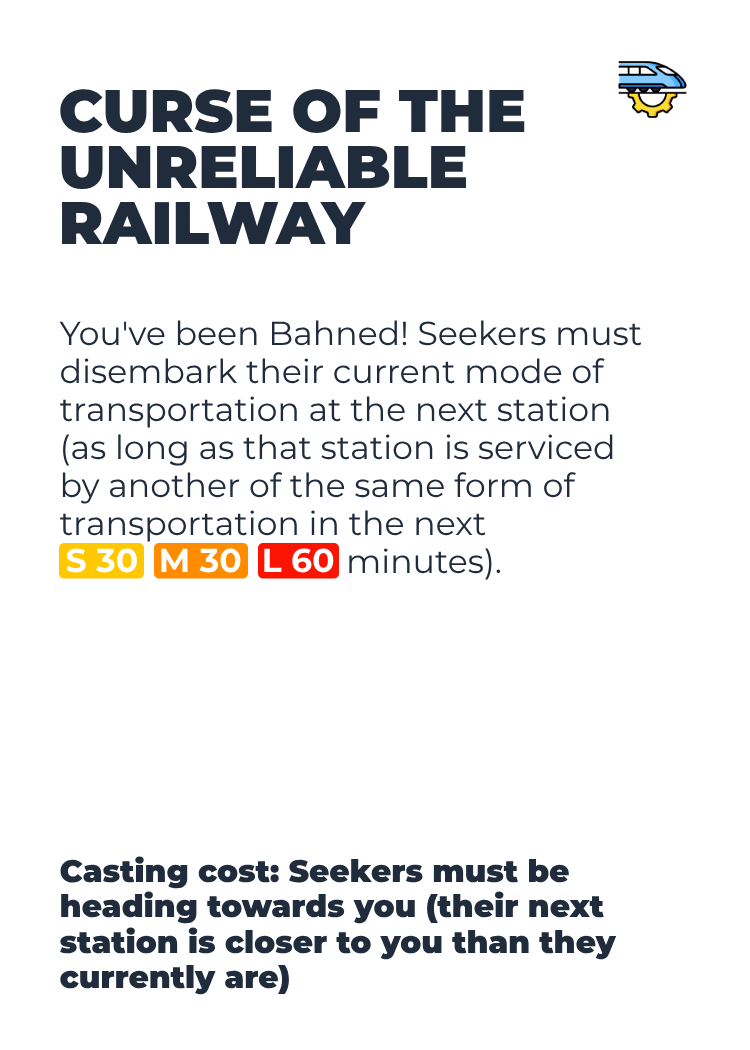
You've been Bahned! Seekers must disembark their current mode of transportation at the next station (as long as that station is serviced by another of the same form of transportation in the next S 30 M 30 L 60 minutes.)
Casting Cost: Seekers must be heading towards you (their next station is closer to you than they currently are)
Additional Rules:
"Next Station," in this context, refers to the next station that the seekers' current mode of transit will stop at; if there are any stops along the line that their current route will skip, those should be disregarded. If you are not sure whether the seekers are on transit, or whether their route will stop at a particular station, you may ask them for that information. If there is any ambiguity, you should tell them what you believe their next station is when this curse is cast to confirm that you didn't misread their tracker. Even if the seekers' current mode of transit would eventually bring them further away from you, this curse may still be played so long as their next station is closer; a line that heads in away from you but temporarily curves towards you is a particularly advantageous situation for this curse.
We felt this card was very much a requirement to playing in Germany, and whilst at least one hider did have it in their deck, it was never actually played in the game. It is basically a variant of the standard game's Curse of the U-Turn.
Curse of the Unknown Deity
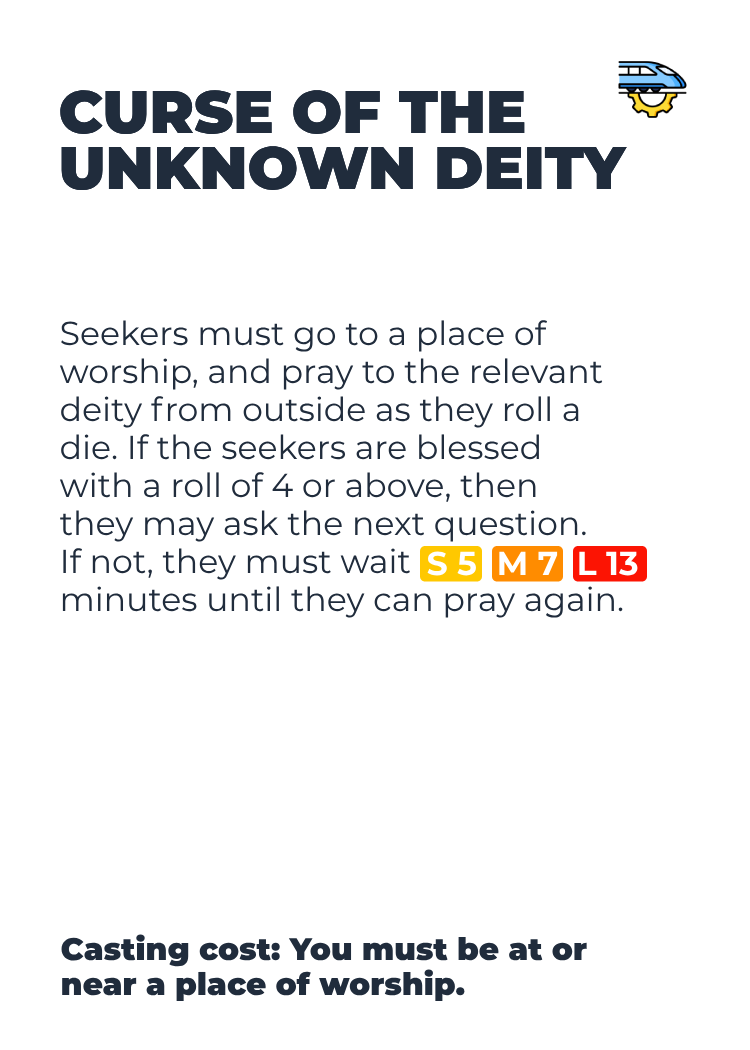
Card Text: Seekers must go to a place of worship, and pray to the relevant deity from outside as they roll a die. If the seekers are blessed with a roll of 4 or above, then they may ask the next question. If not, they must wait S 5 M 7 L 13 minutes until they can pray again.
Casting Cost: Must be at or near a place of worship
Addtional Rules: A place of worship includes any permanent building, temple, or shrine that is marked as such on the outside or on Google Maps. It can belong to any religion or spiritual tradition listed on the 'List of religions and spiritual traditions' page of wikipedia. Random brooks, streams, trees, etc. that are not positively identified as a place of worship do not count, neither does 'capitalism', 'mammon' or similar ideas count as a religion.
Full credit goes to Julia for this one, it was whimsical, very much in the spirit of the game, and worked well when it was played. The only thing we'd add to it is maybe a maximum number of prayers, though a time limit works just as well.
Curse of the Distant Road Trip
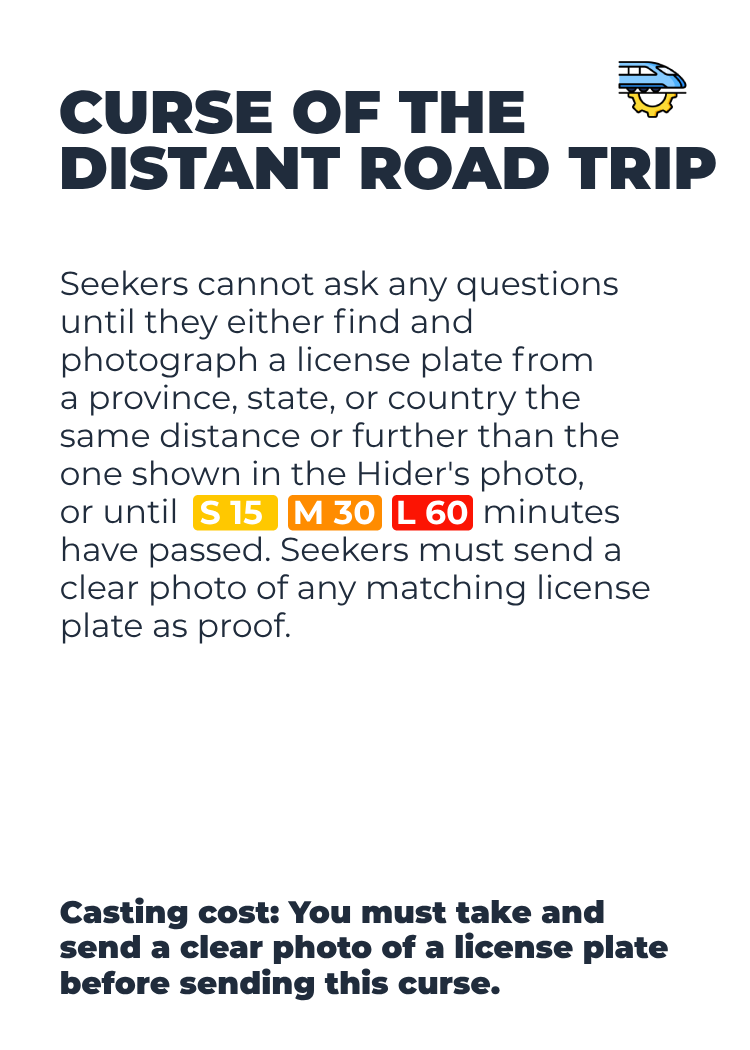
Card Text: Seekers cannot ask any questions until they either find and photograph a license plate from a province, state, or country the same distance or further than the one shown in the Hider's photo, or until S 15 M 30 L 60 minutes have passed. The Seekers must send a clear photo of any matching license plate as proof.
Casting Cost: The Hider must take and send a clear photo of a license plate before sending this curse.
Addtional Rules: In the case of international plates, the distance to the nearest border of that country is counted. Distance is measured from the seeker's location. A Vienna convention sticker or EU-style blue flash on the number plate count as indicating an international plate. If the Seekers have not found a suitable license plate in S 15 M 30 L 60 minutes, the curse is void.
We never actually played this card in the game, but we feel it is a spiritual successor and much more accessible to non-car people than the game's standard Curse of the Luxury Car, and more in line with the idea of the Curse of the Distant Cuisine in the standard game.
Curse of the History-Obsessed Squirrel
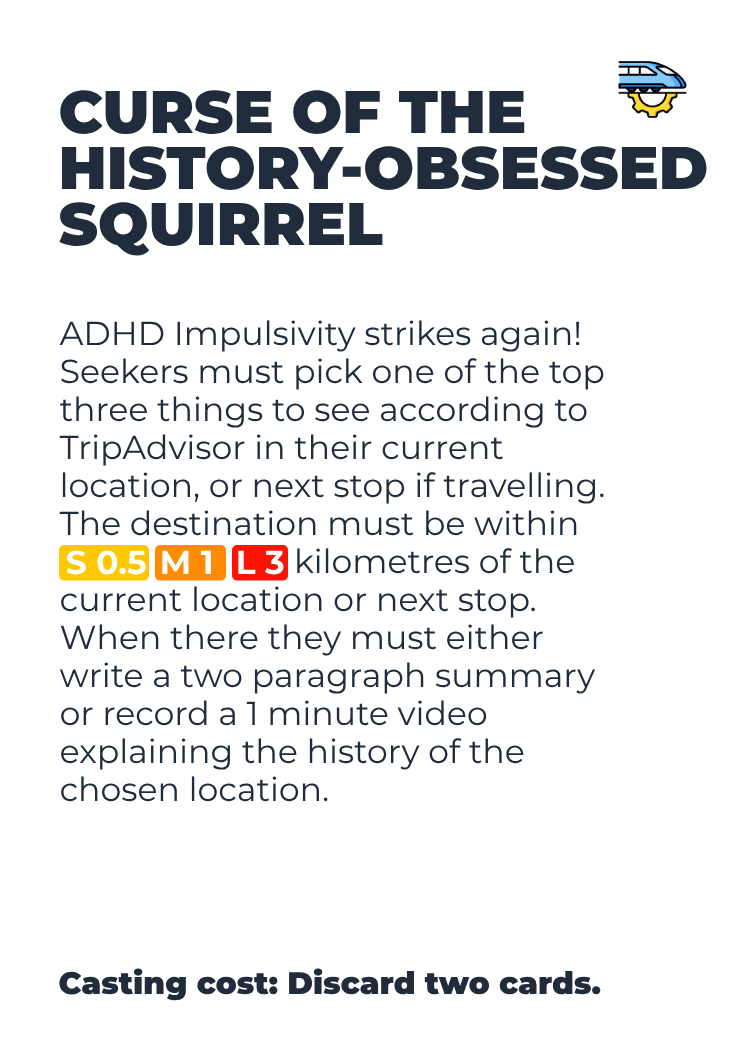
Card Text: ADHD Impulsivity strikes again! Seekers must pick one of the top three things to see according to TripAdvisor in their current location, or next stop if travelling. The destination must be within S 0.5 M 1 L 3 kilometres of the current location or next stop. When there they must either write a two paragraph summary or record a 1 minute video explaining the history of the chosen location.
Casting Cost: Discard two cards.
Addtional Rules: The seekers can choose when to stop if they are travelling. The location must be accessible. If no suitable location is available within the constraints, then the curse is declared void.
This card was only played once, but it was void, as there was no sensible location within 3km on TripAdvisor when it was played. We also discovered that TripAdvisor is really terrible these days, and don't want to rely on it for future card. We did like this idea, see our earlier rant about local flavour, but it requires a serious rewrite.
Curse of the Noble Pursuit
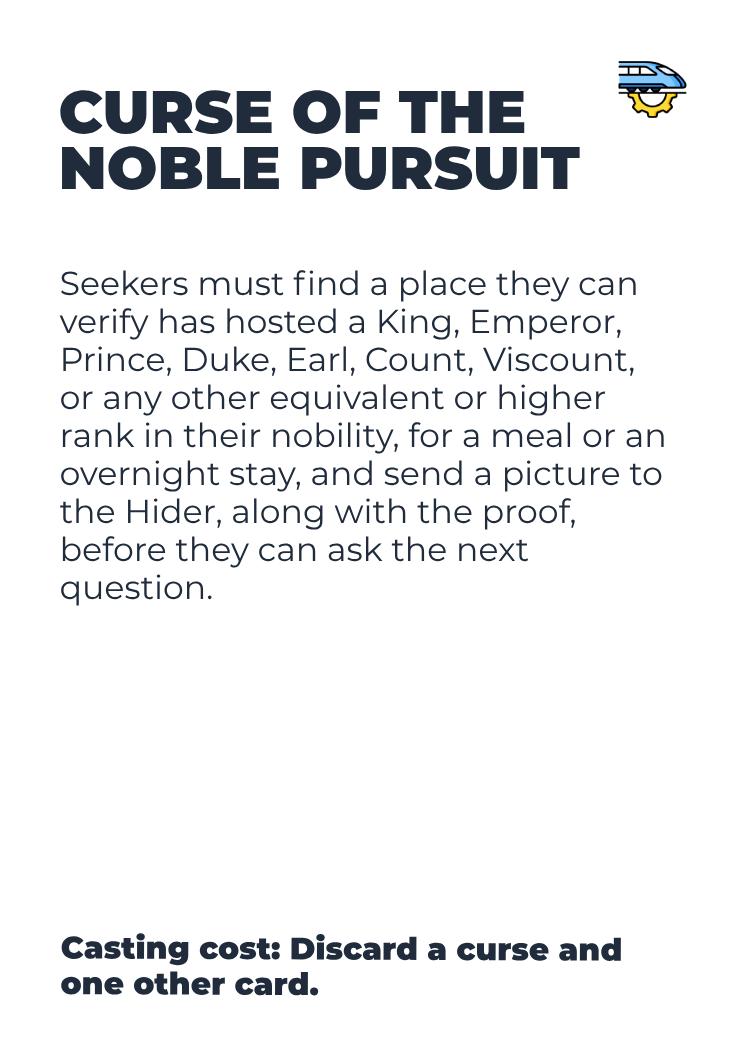
Card Text: Seekers must find a place they can verify has hosted a King, Emperor, Prince, Duke, Earl, Count, Viscount, or any other equivalent or higher rank in their nobility, for a meal or an overnight stay, and send a picture to the Hider, along with the proof, before they can ask the next question.
Casting Cost: Discard a curse and one other card"
Addtional Rules: Seekers must locate and visit a place that has hosted a noble of rank equivalent to Earl/Count or higher for a meal or overnight stay. They must provide photographic evidence and verification (from Wikipedia or on-site signage) before asking their next question.
This card was rewritten half way through the game into a more manageable "Find a building or business with historic record of meeting nobles, or named after a noble". We specifically wanted to exclude squares and streets named after nobles, as there are Kaiser-Wilhelm-Platzes all over Germany.
The first time it was played gave us ample research opportunities, but nothing concrete to point at in the town it was played. The second time, post rewrite, was much more manageable, but did require much less research into local history.
We're not happy with the final version yet, but I'm presenting this card as we had it in the game.
Percentage Time Bonuses
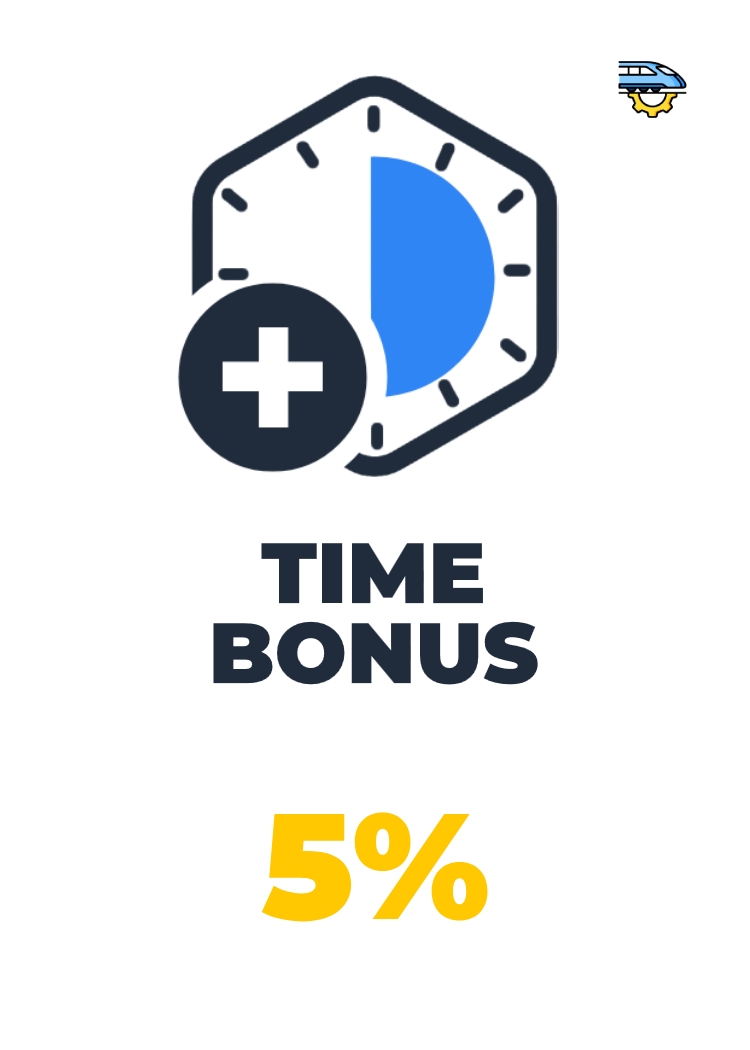
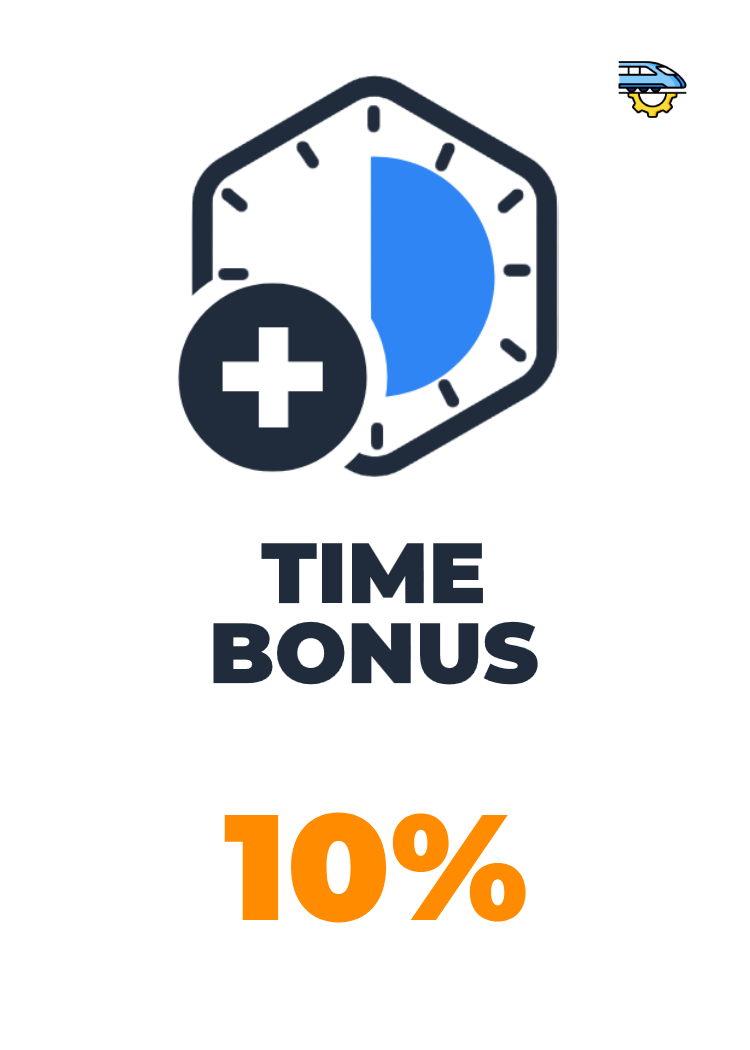
Card Text: Time Bonus 5%, Time Bonus 10%
Addtional Rules: If a time bonus has a percentage value, the percentage is calculated based on the total number of minutes in their round, including any other time bonuses already accumulated, rounded to the nearest minute (0.5 rounds up).
For example, if the hider has a total hiding time of 1 hour, 6 minutes and 23 seconds, and they have a 5 minute time bonus, and a 10% time bonus, they will have 66 mins + 5 mins = 71 mins, and 71 × 10% = 7 mins, so their final hiding time will be 78 minutes, 23 seconds, or 1 hour, 18 minutes and 23 seconds.
We added 5% and 10% time bonuses. This was actually used to good effect in one of the games, especially as there was a duplicate card powerup in the hand, so the ten percent was calculated twice over.
This is a good game, we will play it again
Despite this critique, this is a good game, and we enjoyed it thoroughly. It was also very intense, definitely don't expect to be up and ready to work the day after playing this for three days. It took us the best part of the day to travel back to our base locations as it was.
Will we play it again? Absolutely. We already have played a medium version of the game in Barcelona (which will get a separate report), and we have scheduled ourselves for a large version of the game based in the Netherlands in November.
TL;DR:
- Wheaton’s law applies: Don’t be a Dick
- The Hider is a Dungeon Master: remember the aim of the game is to have fun, and that you will be found
- Put a time limit on cards that don’t have them: we recommend an hour in the large game
- Simulate the game a few times before playing it for real, it helps you get used to the questions and to the map generator
- Take the Curse of Water Weight out of the card deck. It adds nothing but suffering to the game, and not in a fun way.
- Add some local flavour, it's worth it. It is playable without it, though
- Steal our cards
- Wheaton's law always applies. It bears repeating
- We are going to play this game again. You should too.